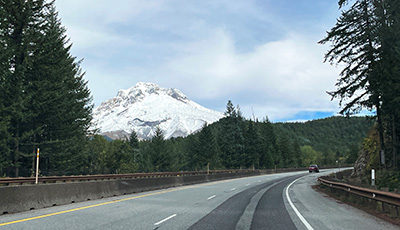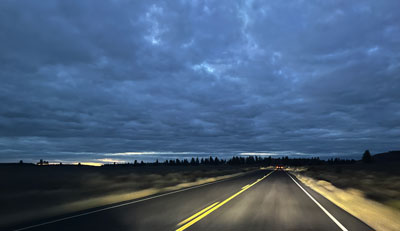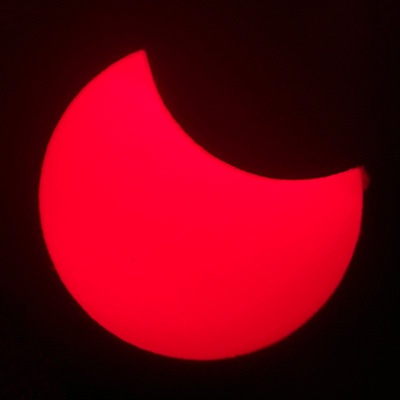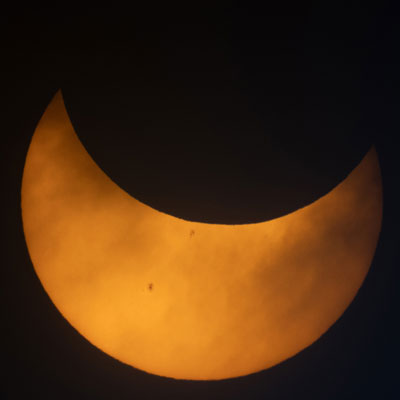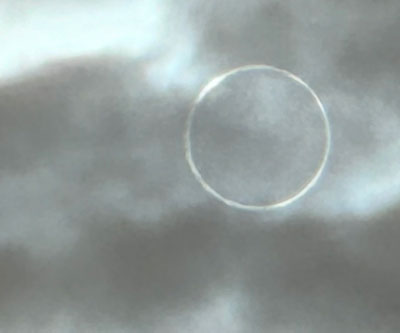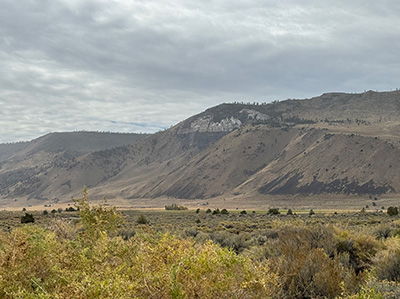|
Annular Solar Eclipse
Paisley, Oregon
October 14, 2023
Despite a less-than-encouraging weather forecast, we drove from Seattle to southern Oregon in hopes of seeing the annular eclipse on October 14, 2023.
Mt. Hood added pop to the scenery along the twisty highway from Portland to Bend.
Our pre-dawn drive from Bend to Paisley featured full cloud cover, an ominous but expected start.
As we got close to Paisley, the eastern sky cleared up, showing a promising amount of blue in the direction of the eclipse. We pulled into the Refuge Church parking lot and started setting up our equipment just as the partial eclipse was starting. We got a couple of photos through the telescopes just before clouds rolled in and completely blocked the sun.
We stared at thick clouds with no sign of the sun while waiting for the eclipse to advance to the annular stage, hoping to get a glimpse. By this time were joined by three other groups of people. As we were getting to the onset of annularity and a bit past, one of the kids in the group called out, "I see it!" Sure enough, the splotchy clouds had thinned out just enough that the sun was partially visible as a bright ring. It was too dim to see through the telescopes with solar filters, but partially visible naked eye.
After watching in amazement as the ring popped in and out through the moving clouds, Tom started video rolling. At the end of the video, the top of the ring is thicker and the bottom of the ring is gone, showing the end of the annular phase.
The round trip from Bend to Paisley was a little more than we were comfortable doing on a single charge, so we arranged to charge at Ana Reservoir RV Park in Summer Lake on the way back. While we ate lunch and took a walk down to the reservoir, the car picked up more than enough range to get us back to the Bend Supercharger and second lunch.
Safety Note
Don't look directly at the sun except through a proper eclipse filter, even through clouds. Even if it doesn't seem overly bright, light outside of the visible range can damage your eyes. The above video was shot while looking at the iPhone's screen, not looking directly at the sun. Although the light from the phone's screen isn't bright enough to cause eye damage, looking through an optical camera viewfinder would not be safe.Total Solar Eclipse April 8, 2024
The next eclipse visible in North America is the total solar eclipse on April 8, 2024. You can learn about it from Eclipsophile and get precise local viewing details from this interactive map. Get prepared now. Look for CE certified solar eclipse glasses from a reputable seller. If you buy them in advance, they are $1 to $2 each in quantity.
Photography Equipment
- Canon R6 Mark II through a 4" Celestron NexStar 4SE 1325mm f/13 telescope with a solar filter.
- iPhone 13 Mini itself and with an eyepiece adapter through a Meade Coronado PST Hydrogen Alpha telescope.
- iPhone 15 Pro.
iPhone Software
- We use Bubble Level + Compass for a quick polar alignment and Polar Scope Align Pro for a more precise alignment.
- Location Log is a handy utility for tracking your position to geotag photos, etc.
Eclipse Resources
- Jay Anderson's Eclipsophile is our starting point for learning about the viewing prospects for each eclipse.
- Xavier Jubier's Interactive Eclipse Map gives local details on the eclipse from any point.
- Weather Underground, Weather.gov, and Windy.com were helpful tools for picking our viewing location.
|
©1996-2024 Tom and Cathy Saxton. You may not copy or reproduce any content from this site without our consent.
